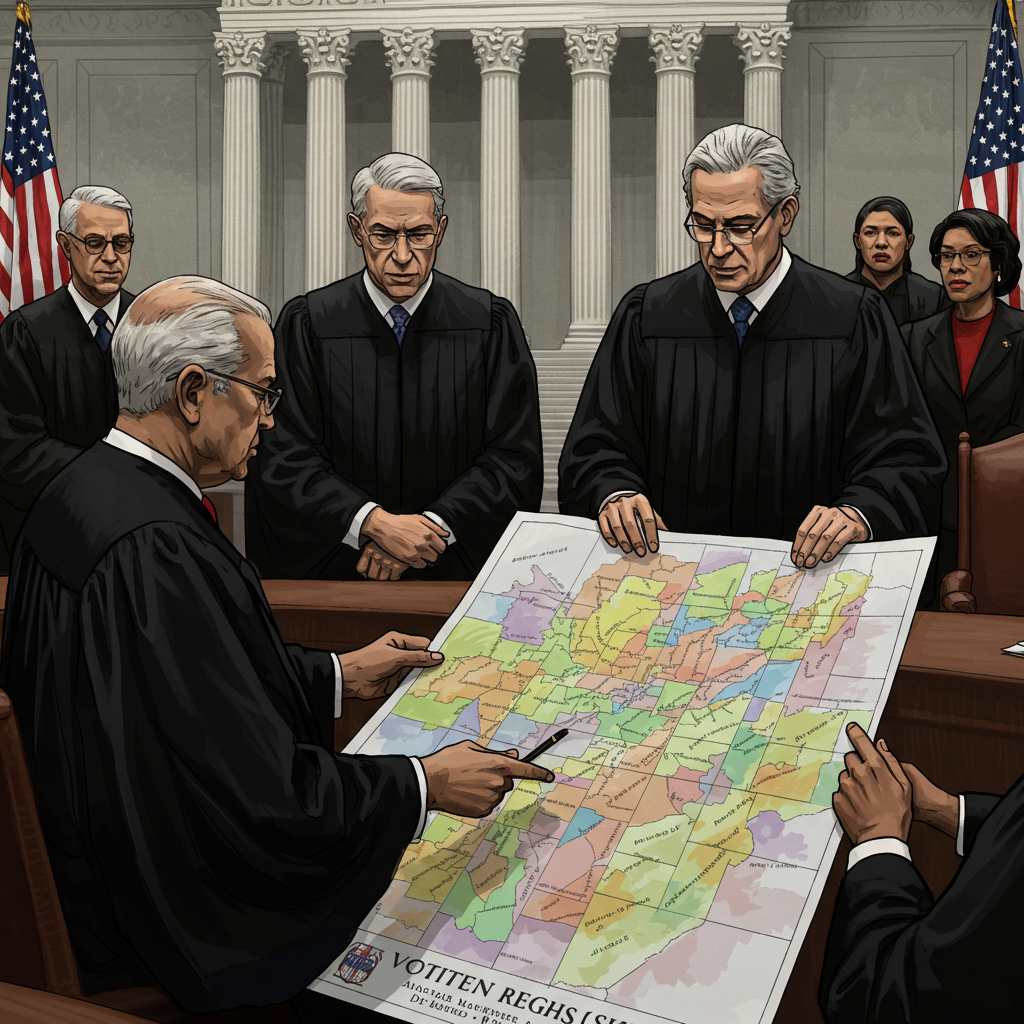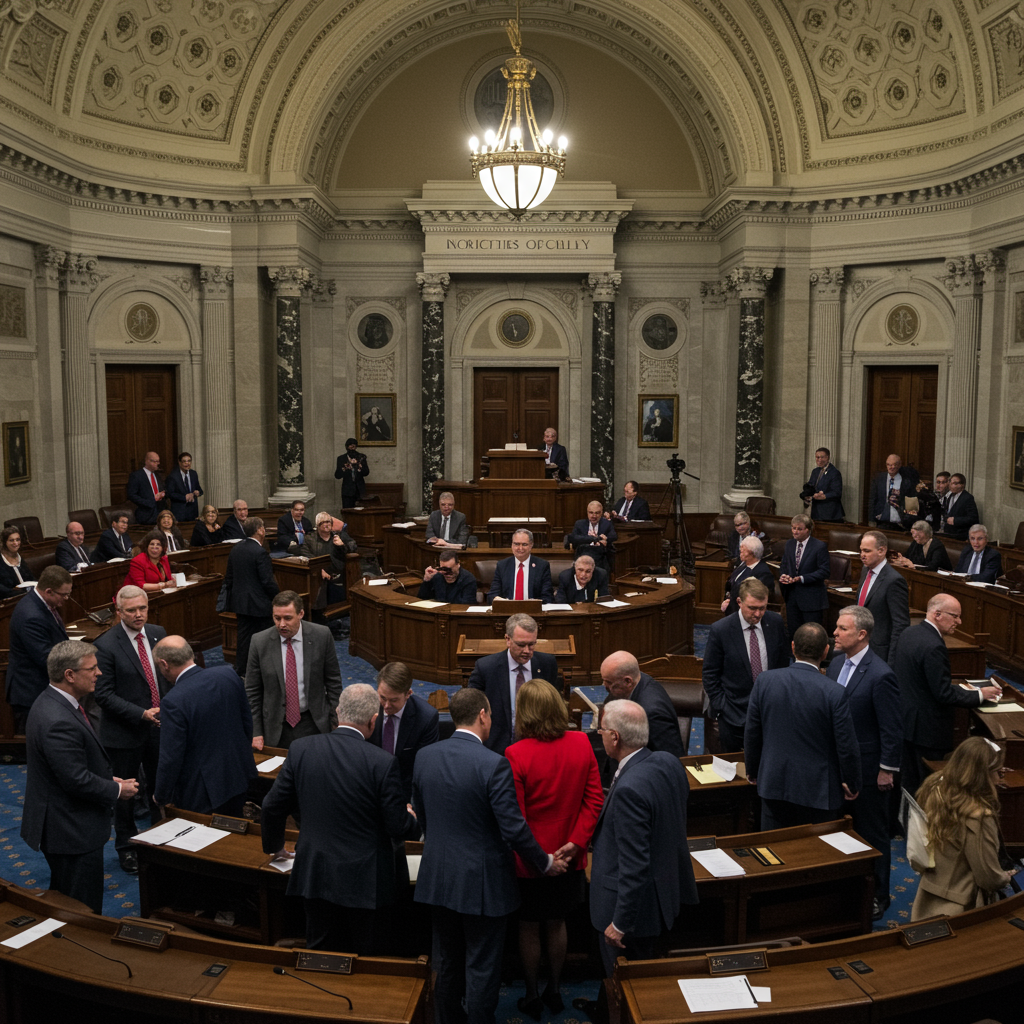The U.S. Supreme Court appears ready to reshape the landscape of American elections, signaling a potential rollback of crucial protections under the landmark Voting Rights Act (VRA). In a closely watched case, Louisiana v. Callais, justices recently heard arguments that could severely restrict the use of race in drawing electoral maps. This development carries profound implications for minority representation and future political power, especially across the South. Experts believe a ruling could fundamentally alter how states craft congressional districts, impacting everything from local school boards to the U.S. House of Representatives.
This contentious legal battle comes more than a decade after other core provisions of the VRA were weakened. The current challenge focuses squarely on Section 2, a vital tool designed to combat racial discrimination in voting for over half a century. Should the court side with Louisiana, it would mark a significant shift, potentially boosting Republican electoral prospects while sparking widespread concerns among civil rights advocates. The ultimate decision, anticipated by early summer 2026, promises to define the future of representative democracy in the United States.
The Louisiana Case: At the Heart of the Debate
At the core of the Supreme Court’s current deliberation is Louisiana’s second majority-Black congressional district. This district, which elected Democratic Rep. Cleo Fields, was created following a lower court’s finding of likely discrimination against Black voters in an earlier map. However, a group of white Louisiana voters, supported by the state and the Trump administration, challenged this new district. They argue that its formation relied too heavily on race, potentially violating the Fourteenth or Fifteenth Amendments to the U.S. Constitution. This assertion sets up a direct conflict with the VRA’s mandate to ensure fair representation.
During 2 1/2 hours of intense oral arguments, the court’s six conservative justices expressed skepticism regarding the district’s reliance on race. Chief Justice John Roberts notably described the district as a “snake,” stretching over 200 miles to connect disparate Black communities. The implication was that such a geographically complex district demonstrated an undue emphasis on racial demographics rather than traditional redistricting principles like compactness.
Conservative Justices Signal a Shift
A key aspect of the arguments involved a notable change in tone from Chief Justice John Roberts and Justice Brett Kavanaugh. Just two years prior, both justices had joined liberal colleagues in a 5-4 decision affirming a likely Section 2 VRA violation in Alabama’s political boundaries. This ruling had led to the creation of new districts in both Alabama and Louisiana, sending two additional Black Democrats to Congress.
However, in the Louisiana case, Roberts suggested the Alabama decision was narrowly focused on its specific facts. He indicated it should not automatically require a similar outcome here. Justice Kavanaugh went further, directly questioning whether the time has come to end the use of race-based districts under the Voting Rights Act, suggesting these remedies shouldn’t “extend forever.” This line of questioning signals a deeper inclination to reassess the VRA’s application. Plaintiffs like Louisiana Solicitor General Benjamin Aguiñaga argued that the Constitution does not permit “government-mandated racial balancing.” Attorney Edward Greim, representing white Louisiana voters, emphasized that only intentional discrimination should warrant a remedy, a high bar to meet.
This perspective resonates with public figures like Shuwaski Young, a Republican candidate for Mississippi Secretary of State. Young asserts that race should not be a motivating factor in drawing electoral districts. He believes race-based districts are unconstitutional and fuel “racially polarized voting,” which he argues protects political power and exacerbates racial division. Young contends that Mississippians no longer live under the same realities that necessitated the 1965 Voting Rights Act, viewing it as designed for equal opportunity, not guaranteed electoral outcomes. He advocates for maps based purely on geography and population, not “racial calculations.”
Defending Section 2: Civil Rights Advocates Respond
Conversely, civil rights groups and the court’s liberal justices vigorously defended Section 2 of the Voting Rights Act. Janai Nelson of the NAACP Legal Defense Fund, representing Black Louisiana voters, warned that a ruling against them would lead to a “staggering reversal of precedent” and “chaos” nationwide. She stressed Section 2’s crucial role in preventing vote dilution and creating “opportunity districts.” These districts have been instrumental in diversifying leadership and ensuring equal opportunity for minority voters.
Justice Elena Kagan reiterated that Section 2 specifically addresses the “effects of discrimination.” She pressed on the need to acknowledge current conditions of “racially blocked voting” that necessitate remedies. Justice Sonia Sotomayor argued that race is “always” a factor in redistricting. She pointed out that Black voters are often “packed” into certain areas, effectively preventing them from electing candidates of their choice. Justice Ketanji Brown Jackson animatedly defended Section 2, questioning why only intentional discrimination should be remedied. She highlighted how map discussions often overlook underlying race-based residential patterns. She affirmed that Section 2 addresses the effects of discrimination, not just intent, and that it “doesn’t need a time limit” because it only triggers action when necessary conditions exist. Its focus on race, she explained, stems from it being “the initial problem.” These justices emphasized that the VRA aims to overcome systemic barriers, not to mandate specific racial outcomes.
Historical Context and Broader Implications
The current legal challenge unfolds against a backdrop of evolving interpretations of the Voting Rights Act since its enactment in 1965. The VRA, a centerpiece of the Civil Rights Movement, successfully opened the ballot box to Black Americans and significantly reduced persistent discrimination in voting. However, its protections have faced repeated challenges.
The 2013 Shelby County v. Holder decision gutted Section 5 of the VRA. This section had required states with a history of discrimination to get federal “pre-clearance” for election changes. That ruling left Section 2 as the primary federal tool for challenging discriminatory election practices, thus increasing its importance. The current Supreme Court conservative majority has also shown skepticism of race-conscious policies, most recently ending affirmative action in college admissions. These precedents indicate a broader judicial philosophy that questions the ongoing necessity of race-based remedies.
A ruling in favor of Louisiana could empower state legislatures to redraw congressional maps in southern states and beyond. This action could eliminate many majority-Black and Latino districts that typically favor Democratic candidates. This potential outcome follows a 2019 Supreme Court decision that already granted legislatures broad authority to draw highly partisan districts, with review limited to state courts. Weakening Section 2 would essentially remove any federal limits on how states draw electoral districts, potentially leading to extreme racial gerrymandering by whichever party controls state legislatures. The debate also invokes key legal concepts like “racially polarized voting,” central to the 1986 Thornburg v. Gingles ruling, which helps determine if minority voters can elect candidates of their choice. The practice of “packing and cracking,” concentrating minority voters into a few districts while diluting their votes elsewhere, is also a central concern.
Beyond Congressional Districts: Impact on Local Governance
The potential impact of weakening Section 2 extends far beyond congressional maps. This vital provision has been instrumental in challenging discriminatory election structures in local offices nationwide. Historically, Section 2 has led to the conversion of at-large election systems (where candidates are elected by the entire jurisdiction) to district-based systems. This change significantly increased minority representation on bodies such as school boards, town councils, and county commissions.
History professor J. Morgan Kousser has tallied 1,363 cases since 1965 where Section 2 resulted in successful outcomes or settlements, with 937 of these specifically addressing local offices. A significant curtailment of Section 2 could roll back decades of progress in diversifying local leadership. It might leave minority communities with fewer avenues to challenge electoral systems that dilute their voting power. This broader impact underscores the sweeping nature of the Supreme Court’s upcoming decision.
Frequently Asked Questions
What is Section 2 of the Voting Rights Act and why is it currently being challenged?
Section 2 of the Voting Rights Act (VRA) is a crucial provision enacted in 1965 to combat racial discrimination in voting. It prohibits election practices that result in a denial or abridgment of the right to vote based on race or color. This includes practices that dilute the voting strength of racial minorities. It allows courts to order new electoral maps if existing ones dilute minority votes. The VRA is being challenged because a Republican-led effort, supported by the Trump administration and white voters in Louisiana, argues that creating majority-minority districts to remedy past discrimination relies too heavily on race, potentially violating constitutional amendments. They contend that such districts lead to “racially polarized voting” and should not be a permanent feature of redistricting.
How could the Supreme Court’s ruling in Louisiana v. Callais impact future elections, particularly in Southern states?
A ruling in favor of Louisiana could significantly impact future elections, especially in Southern states. If the Supreme Court limits Section 2, state legislatures would have fewer constraints on how they draw electoral districts. This could lead to widespread racial gerrymandering, where districts are drawn to diminish the voting power of minority groups. Such an outcome would likely boost Republican electoral prospects by potentially eliminating majority-Black and Latino districts, which tend to favor Democratic candidates. This could decrease minority representation in Congress and at the local level, further entrenching partisan control and reshaping the political landscape for decades to come.
What are the core arguments for and against race-based electoral districts in this Supreme Court case?
Arguments against race-based electoral districts, presented by Louisiana and supporting parties, claim that intentionally creating such districts constitutes “government-mandated racial balancing” that violates the Fourteenth or Fifteenth Amendments. They argue that race should not be a predominant factor in redistricting and that the country has reached an “endpoint” where race-conscious remedies are no longer necessary or constitutional. Some contend that only intentional discrimination should be remedied.
Arguments for race-based districts, defended by civil rights groups and liberal justices, emphasize Section 2’s role in combating the effects of racial discrimination and vote dilution. They highlight the historical context of the Voting Rights Act in addressing systemic barriers that prevent minority voters from electing candidates of their choice. They argue that Section 2 creates “opportunity districts” essential for ensuring fair representation and that eliminating it would be a “staggering reversal of precedent,” leading to chaos and a rollback of decades of progress in diversifying leadership.
The Path Ahead: A Defining Moment for Voting Rights
The Supreme Court’s eventual ruling in Louisiana v. Callais will undoubtedly be one of the most consequential decisions regarding voting rights in recent memory. It reflects a deep ideological divide within the court and the nation about the role of race in American democracy and the ongoing necessity of civil rights legislation. The outcome could significantly alter the balance of power in Congress and redefine the scope of federal protection against vote dilution. As the legal battle concludes, all eyes will be on the court for a decision that will profoundly shape the future of electoral districts and minority representation. Understanding this complex issue is paramount for every citizen invested in the integrity and fairness of our electoral process.



